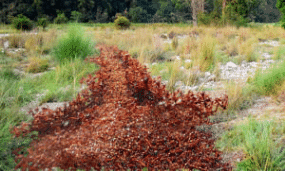Social Organisation In Insects | Zoology Optional Notes for UPSC PDF Download
| Table of contents |

|
| Introduction |

|
| Social Life in Termites |

|
| Social Structure of a Bee Colony |

|
| Social Organization in Wasps |

|
| Ant Societies |

|
Introduction
In the insect world, social life has only evolved significantly in two orders: Isoptera (termites) and Hymenoptera (bees, wasps, and ants). These insects form nests and live in colonies characterized by division of labor and intricate social interactions.
Social Life in Termites
Termites, evolving approximately 300 million years ago, pioneered colony living and developed a sophisticated social system. Despite their small size (3-4 mm), termite colonies exhibit remarkable organization.
Queen and Reproduction
The termite queen, an astonishing 4-inch giant, lies motionless in a royal chamber. Incapable of moving due to small legs, the queen relies on workers for all daily activities. Remarkably, the queen lays eggs at a staggering rate of two per second, amounting to 6,000 to 7,000 eggs per day. Their lifespan spans 15 to 20 years.
Worker and Soldier Castes
- Soldiers: Equipped with long, dagger-like mandibles, soldiers defend the nest. Nasutes specialize in chemical warfare, producing a corrosive chemical to dissolve enemies' skin and create galleries through rocks.
- Workers: Devoted to the colony, workers chew wood to feed the queen and larvae, cultivate fungus gardens during lean periods, and maintain the nest.
Social Structure of a Bee Colony
Bee colonies, exemplified by remarkable order, exhibit a population ranging from 40,000 to 80,000 individuals during spring and honey flow periods.

Queen's Role and Reproduction
The queen, larger than workers, secretes a pheromone called "queen substance" to maintain colony cohesion. In multiqueen colonies, emerging queens engage in lethal competition, with the survivor assuming leadership.
Drones and Workers
- Drones: Haploid fertile males, drones mate with the queen during nuptial flights and are subsequently driven out of the hive and perish.
- Workers: Genetically sterile females, workers undertake hive maintenance, larval feeding, wax secretion, and foraging duties. Their roles evolve throughout their lives.
Social Organization in Wasps
Wasps, belonging to the Vespidae family, exhibit diverse nesting habits and social structures among their approximately 75,000 species.

Nesting Behavior
- Social wasps create paper nests primarily from wood pulp, gathered locally and mixed with saliva.
- Mud daubers and pollen wasps construct mud cells, while potter wasps build vase-like nests from mud.

Ant Societies
Ants, distinguished by their tireless work ethic, represent a highly developed social system, second only to humans.

Colony Structure
Ant colonies range from a few thousand to over 500,000 individuals. Their nests, called formicaria, exhibit various designs.
Caste Specialization and Communication
- Ants display polyethism, with castes specializing in specific colony duties.
- Communication relies on a sophisticated chemical language involving pheromones. Tropholaxis, involving antennal caressing and food exchange, maintains colony cohesion.
Nesting Habits
- Most ants excavate nests in the ground or wood.
- Some construct suspended nests on trees using earth, carton, wax, or silk.
- Desert ants build crater-like nests to regulate temperature, while tropical ants like Oecophylla create nests by webbing leaves with silken thread produced by their larvae.
|
181 videos|346 docs
|


















